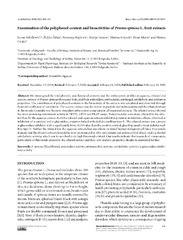Приказ основних података о документу
Examination of the polyphenol content and bioactivities of Prunus spinosa L. fruit extracts
| dc.creator | Veličković, Ivona | |
| dc.creator | Žižak, Željko | |
| dc.creator | Rajčević, Nemanja | |
| dc.creator | Ivanov, Marija | |
| dc.creator | Soković, Marina | |
| dc.creator | Marin, Petar | |
| dc.creator | Grujić, Slavica | |
| dc.date.accessioned | 2020-04-29T12:03:41Z | |
| dc.date.available | 2020-04-29T12:03:41Z | |
| dc.date.issued | 2020 | |
| dc.identifier.issn | 0354-4664 | |
| dc.identifier.uri | http://www.serbiosoc.org.rs/arch/index.php/abs/article/view/4932 | |
| dc.identifier.uri | https://radar.ibiss.bg.ac.rs/handle/123456789/3652 | |
| dc.description.abstract | We investigated the total phenolic and flavonoid contents and the anthocyanin profiles in aqueous, ethanol and acetone extracts of Prunus spinosa (Rosaceae) fruit, and their antioxidant, antibacterial, antifungal, antidiabetic and antitumor properties. The contribution of polyphenol contents to the bioactivity of the extracts was calculated and observed through Pearson’s coefficient of correlation. The acetone extract was the richest in phenols and anthocyanins and the ethanol extract in flavonoids. Cyanidin was the most abundant anthocyanin compound in all examined extracts. The ethanol extract showed the most promising antioxidant activity in DPPH, ABTS and FRAP assays. Tested bacteria were more affected by the ethanol than by the aqueous extract. Both the ethanol and aqueous extracts exhibited potential antidiabetic effects, observed as inhibition of α-amylase and α-glucosidase, enzymes linked with diabetes mellitus type II. The ethanol extract was a potent α-glucosidase-inhibitor with a significantly lower IC50 value than the positive control, glucobay, used to treat diabetes mellitus type II. Neither the ethanol nor the aqueous extracts had any effects on tested human malignant cell lines. Our results indicate that the ethanol extract showed the most pronounced in vitro antioxidant and antimicrobial effects, and a potential antidiabetic activity, which can be ascribed to its high flavonoid content. Our results indicate that research of compounds, particularly of flavonoids present in the ethanol extract and their anti-diabetic properties should be examined further. | en |
| dc.relation | info:eu-repo/grantAgreement/MESTD/Basic Research (BR or ON)/173029/RS// | |
| dc.relation | info:eu-repo/grantAgreement/MESTD/Basic Research (BR or ON)/173032/RS// | |
| dc.relation | info:eu-repo/grantAgreement/MESTD/Basic Research (BR or ON)/175011/RS// | |
| dc.rights | openAccess | |
| dc.rights.uri | https://creativecommons.org/licenses/by-nc-nd/4.0/ | |
| dc.source | Archives of Biological Sciences | |
| dc.subject | P. spinosa (blackthorn) | |
| dc.subject | Antioxidant activity | |
| dc.subject | Antimicrobial activity | |
| dc.subject | Antidiabetic activity | |
| dc.subject | α-glucosidase inhibitory activity | |
| dc.title | Examination of the polyphenol content and bioactivities of Prunus spinosa L. fruit extracts | en |
| dc.type | article | en |
| dc.rights.license | BY-NC-ND | |
| dcterms.abstract | Жижак, Жељко; Грујић, Славица; Величковић, Ивона; Марин, Петар; Иванов, Марија; Соковић, Марина; Рајчевић, Немања; | |
| dc.rights.holder | © 2020 by the Serbian Biological Society. | |
| dc.citation.issue | 1 | |
| dc.citation.volume | 72 | |
| dc.identifier.doi | 10.2298/abs191217004v | |
| dc.identifier.scopus | 2-s2.0-85084237331 | |
| dc.identifier.wos | 000524505000012 | |
| dc.citation.apa | Veličković, I., Žižak, Ž., Rajčević, N., Ivanov, M., Soković, M., Marin, P., et al. (2020). Examination of the polyphenol content and bioactivities of Prunus spinosa L. fruit extracts. Archives of Biological Sciences, 72(1), 105–115. | |
| dc.citation.vancouver | Veličković I, Žižak Ž, Rajčević N, Ivanov M, Soković M, Marin P, Grujić S. Examination of the polyphenol content and bioactivities of Prunus spinosa L. fruit extracts. Arch Biol Sci. 2020;72(1):105–15. | |
| dc.citation.spage | 105 | |
| dc.citation.epage | 115 | |
| dc.type.version | publishedVersion | |
| dc.identifier.fulltext | https://radar.ibiss.bg.ac.rs/bitstream/id/6131/ABS-72-1-105-115.pdf | |
| dc.citation.rank | M23 |

